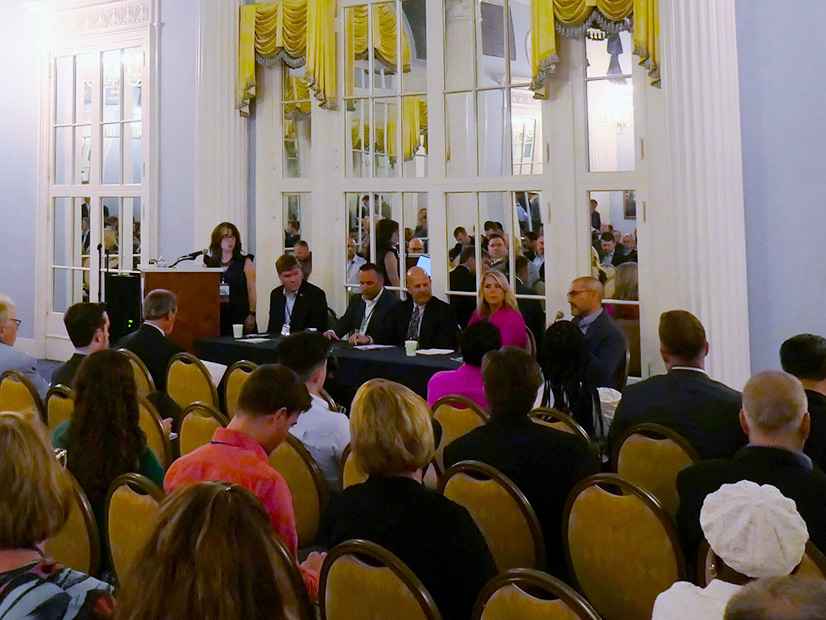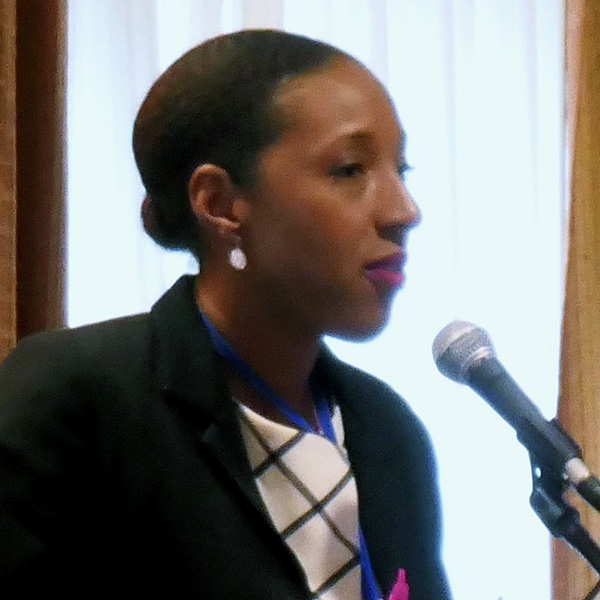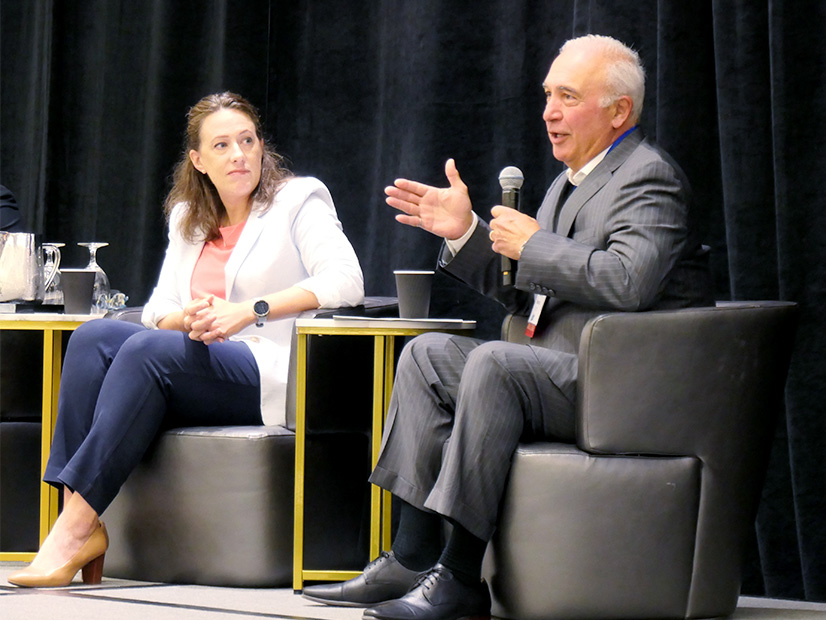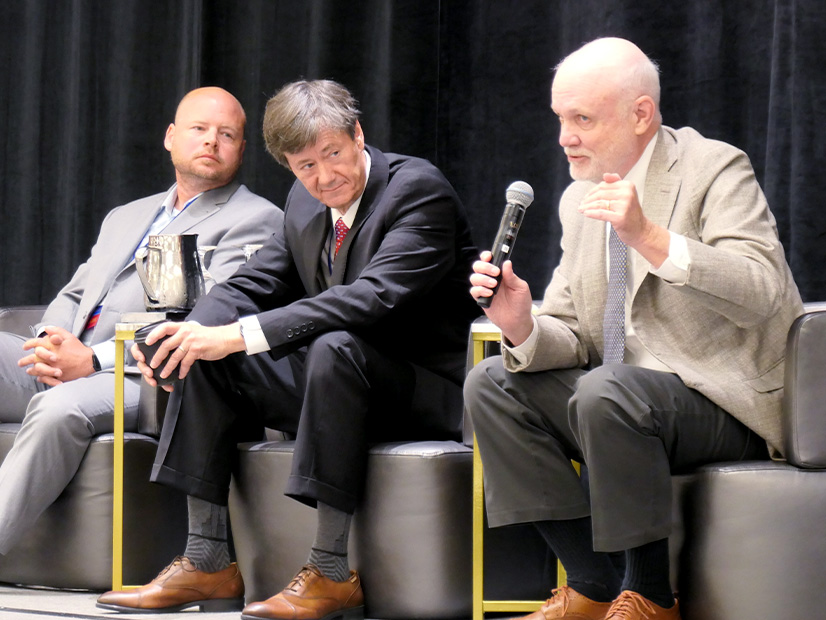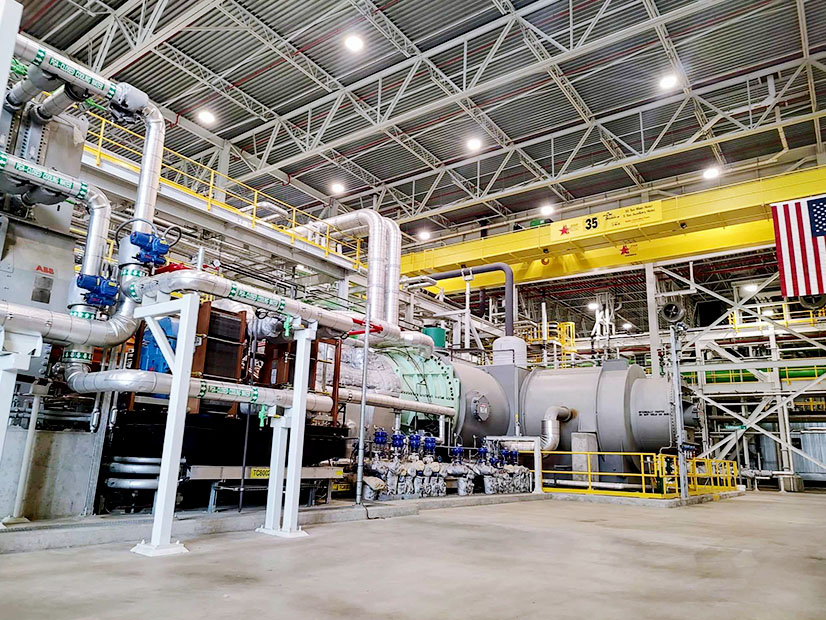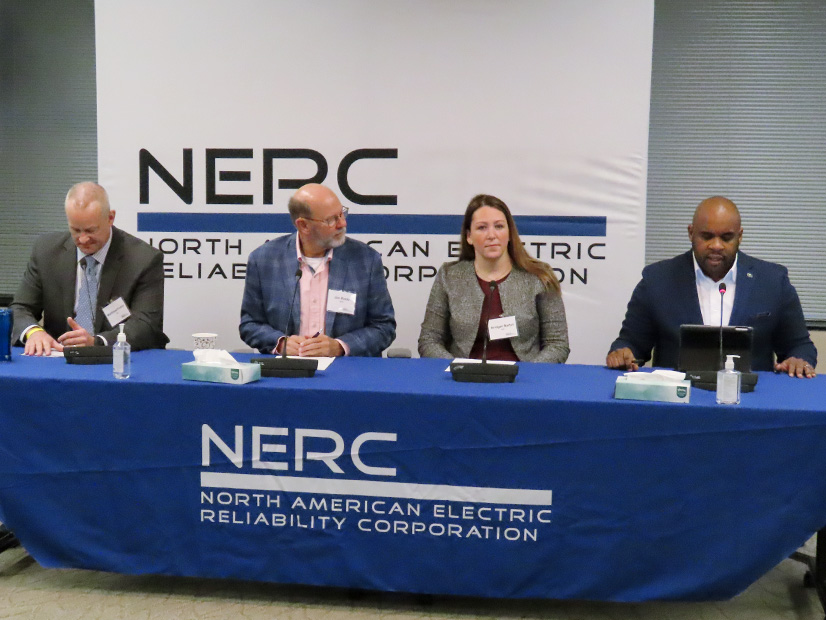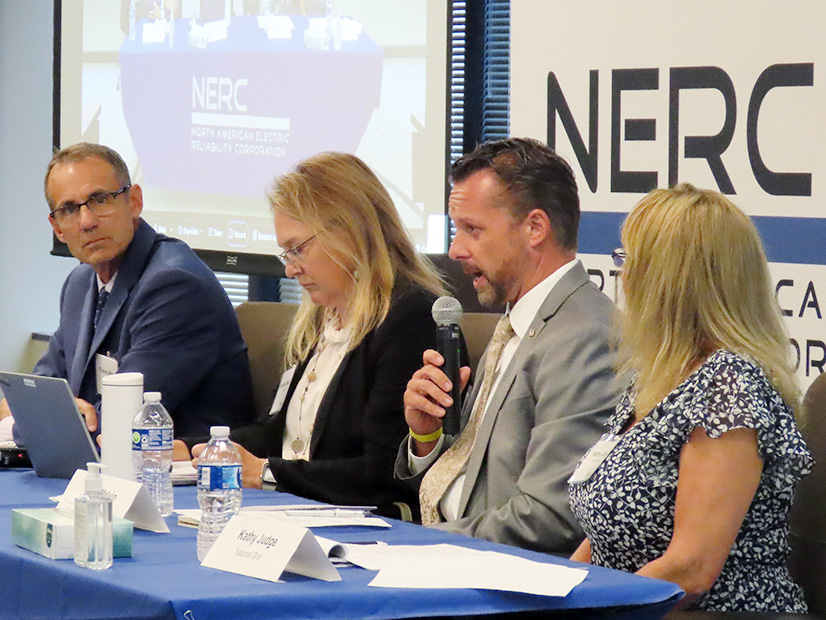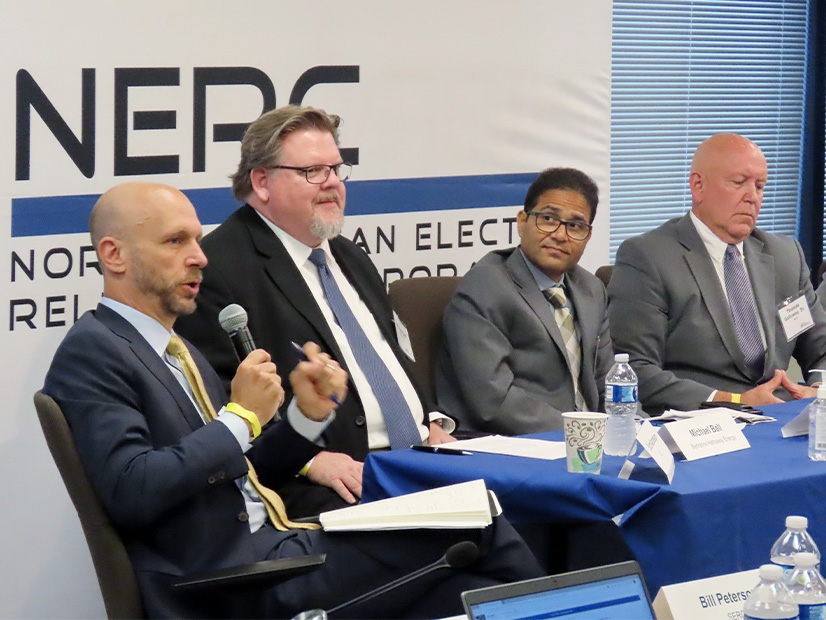GRAND RAPIDS, Mich. — The annual Mid-America Regulatory Conference (MARC) Aug. 6-9 again centered on the clean energy conversion and transmission expansion, this time with an undercurrent of equity.
MARC’s 2023 conference, “Grand Vision: Past, Present, Future” originally was planned for late spring 2020 but was derailed by the pandemic until Aug. 6-9.
“It’s a conference more than four years in the making,” Michigan Public Service Commission Chair Dan Scripps said, welcoming regulators, utility representatives and “Barbies, Kens and even Allans” to the conference.
Equity Takes Center Stage
Multiple Indiana and Michigan-based grassroots equity and climate activist groups attended MARC this year, pressing regulators and utility representatives to decarbonize faster while addressing longstanding disparities in the grid’s design.
Wisconsin PSC Chair Rebecca Cameron Valcq said the energy transition affords the industry “a once-in-a-generation opportunity and responsibility” to include vulnerable communities in environmental justice. She said those communities have good reason to distrust the systems in place and have been neglected “for hundreds of years.”
Regulatory initiatives often are “dense and obtuse,” Cameron Valcq said, making an informed and participating public an uphill battle. She said “there’s more work to be done” in ensuring the public know where and when to comment.
Becca Jones-Albertus, director of the Solar Energy Technologies Office at the U.S. Department of Energy, said an “unevenly distributed” transition is underway, where some parts of the country already have rapidly transformed while other parts have little idea of what’s in store for them.
Jones-Albertus said over the next few years, she expects 5-10% of power consumed to originate on the distribution system.
“We’re at a fork in the road,” said Jeffrey Schlegelmilch, director of the National Center for Disaster Preparedness at Columbia Law School. He said the industry can either view the transition through the “lens of equity” and extend the benefits of innovation to all, or it can exclusively lavish investments on wealthier areas, forcing poorer Americans to pay more for power, be neglected from environmental redress and continue bearing the brunt of reliability breaches and dangerous weather.
Schlegelmilch said societal and economic costs will be much lower if the industry brings everyone along on the clean energy overhaul. He said he’s performed analyses where the medical costs of exacerbated health conditions and the “cascading impacts” of those costs alone make replacing a fossil fuel generator with a battery storage facility cost-effective in communities. But he also said that raises the question of who ultimately pays for action versus inaction.
Midwest Building Decarbonization Coalition’s Marnese Jackson said historic racism, capitalism and a single-minded drive for corporate profit is making a truly equitable decarbonization increasingly unattainable. She called for an emphasis on shifting away from “dirty” natural gas as soon as possible.
Consumers Energy CEO Garrick Rochow said equity and environmental justice can be baked into the energy transformation. He said he believes carbon capture will factor heavily into the clean conversion, and natural gas generation will “fill in the gaps” and then “diminish.” Rochow said once the grid is sufficiently greened, green hydrogen can enter the conversation.
Rochow also said Consumers has conducted unconscious bias analyses in its outage restorations and grid investments practices, something it “should have done 20 years ago.”
“What we’ve found is we’re investing more in our most vulnerable customers because the grid is in worse shape in those areas,” he said.
In a session on planning a just transition for power plant communities, Hilary Scott-Ogunrinde, deputy director of energy and utility at the Illinois Department of Commerce and Economic Activity, said the state is trying to “rectify the wrongs of the past” through the Climate and Equitable Jobs Act (CEJA).
She asked the audience to guess how many coal plants have closed in Illinois in the past decade. After speculations ranging from five to 20, she said the number is 11.
Scott-Ogunrinde said after the rash of closures, Illinois passed CEJA, which contains grants for coal-to-solar facility changeovers, both for underprivileged individuals seeking to invest in renewable development and for communities transitioning from coal, nuclear, natural gas or mining operations.
Larry Steckelberg, an administrator of community services at the Michigan Department of Treasury, said Windsor, Ontario’s twinkling lights across the Detroit River are in stark contrast to Detroit’s lack of recreational waterfront, brownfield sites, abandoned factories and shuttered coal plants. He said River Rouge, Mich., the former site of heavy industry and DTE Energy’s River Rouge coal plant, which closed in 2021, is one of the most polluted sites in Michigan and will take several years of remediation until people are enticed to move there.
Steckelberg said revitalizing a former coal plant city is a long-term project, often taking 15-20 years, with cities “swept up in global events” out of their control. He said he personally couldn’t predict how fast coal would fall out of fashion globally.
Steckelberg said the town of Covert, Mich., was unprepared for the closure of the Palisades nuclear plant, even though indications were clear. He urged communities to diversify energy sources and not “just become a site” for solar panels because it’s the trendy resource now. But he acknowledged that the list of federal resources and the requirements can be “bewildering” for some communities.
“Putting in layers of bureaucracy does not get the help that people need,” Scott-Ogunrinde agreed. “…If we’re going to have the money available, then have the money available. Because the people filling out the forms, they need it. Even if they don’t have 20 pages of documentation.”
EPA Senior Adviser Jon Grosshans said historically the U.S. has supported communities suffering manufacturing losses, but it hasn’t provided backing for communities that transition from coal plants.
Grosshans said the federal government is seeking to create a “front door” for financial resources for transitioning communities.
“Sitting around in 2019, it was pretty obvious to us that this was going to be a decade of closing more coal and bringing on more renewables,” said Emily Fisher, Edison Electric Institute executive vice president of clean energy.
Fisher said EEI quickly realized that net-zero plans would need to incorporate dispatchable technologies with the assistance of carbon capture, green hydrogen and long-duration storage.
“No company has released a plan that hasn’t carefully thought this through,” she said.
But Fisher said it became apparent over the past few years that “maybe this decade isn’t going to be as easy as we thought it was going to be,” referring to how difficult it remains for new generation to clear interconnection queues and receive grid treatment.
Fisher also said post-pandemic, utilities have become more acutely aware of affordability. She said when utilities raise concerns about customer affordability, it’s often perceived as utilities trying to stall the clean energy transition. But she said utilities are justified in their concern whether costs can be recovered from ratepayers.
DTE Energy CEO Jerry Norcia said DTE’s latest integrated resource means his utility is mounting an “aggressive” net-zero plan. (See DTE, Activists Announce Agreement to Exit Coal by 2032.)
“Solar seemed unreachable from an economics standpoint about 10 years ago. What seemed impossible a decade ago has become very, very possible,” Norcia said.
Norcia also said he’s optimistic about green hydrogen and predicted the technology will improve, and costs will plummet so that what seemed insurmountable will become achievable.
Norcia also said DTE’s service territory has begun to see “violent storms… and weather patterns that were reserved for states south of us,” upping the pressure to make infrastructure investments for the sake of reliability. He said the climate crisis and growing demand for electrification means utilities need to “build the grid out slightly ahead of time.” He also said worsening weather means utilities need to seriously consider “how to get stuff underground,” indicating burying lines.
“That’s something we’re going to start experimenting with and seeing how we can get the costs down,” he said.
Google Global Head of Energy Caroline Golin said Google is conscious it demands a lot of electricity and wants to accelerate the switch to carbon-free sources. She said Google is focused on how to partner with suppliers on pilot projects for green hydrogen, long-duration storage and carbon capture.
“I can tell you this [carbon-free] growth is coming, it’s coming now, it’s coming fast. We wanted it yesterday. …We will not grow somewhere where we don’t see a goal,” she said of renewable energy targets.
Golin also said Google doesn’t want to wait on a “six-year interconnection queue” before planned generation can link up to the grid. Google aims to achieve net-zero emissions across all operations by 2030.
“We make two-year, three-year business commitments,” she said.
Towering Transmission Investments
“What we do know is that the future is going to [be] significantly more complex than anything we’ve ever planned for before,” SPP Vice President of Engineering David Kelley said, noting that the U.S. has sustained about 360 weather and climate disasters since 1980 where overall damages and costs have reached at least $1 billion. “Planning for a loss of load event every 10 years is no longer going to cut it,” he said.
Advanced Power Alliance’s Steve Gaw said transmission system expansion is necessary to unlock clean, low-cost energy and shrink congestion.
Gaw said if grid operators aren’t proactively planning, “you’re risking being 10 years behind.”
“In the words of Dwight Eisenhower, I’d say plans are nothing — and basically worthless — but planning is everything,” he said.
Gaw also said transmission projects — even ones built to further a lone public policy goal — rarely fulfill a single purpose. He said transmission often offers a myriad of economic, reliability and decarbonization benefits. He said it’s nearly impossible to build transmission for a single goal.
“You’ve got to think about the consequences if you don’t make that investment,” ITC’s Charles Marshall said of transmission planning, pointing out that his friend’s electric bill will contain an up to $10 surcharge every bill for decades to fund the recovery efforts after Winter Storm Uri because the system wasn’t built to weather the storm.
FERC Commissioner Mark Christie said contrary to the perception of a crumbling and decrepit transmission system, there’s a surge in new transmission projects.
“We’ve heard a lot about how the grid is old, it’s creaky, it’s built for a World War II era,” he said.
But Christie said the national transmission rate base has tripled in the past decade and is set to double over the next eight years. He said grid planners need to be sensitive to regional costs. “You ain’t seen nothing yet” in terms of how high transmission price tags will ascend in the coming years, Christie warned.
Siting infrastructure isn’t going to get any easier, multiple panelists said.
“There’s so much development that communities are reacting. They’re being asked to solve global energy infrastructure problems, and they’re thinking ‘that’s not my problem,’” University of Michigan Director Sarah Mills said.
Mills said developers should sell their projects as solutions to lift farmers’ incomes and increase local tax bases.
Mills also said regulators should be upfront about collecting comments and if the contents stand to change the outcome in a decision.
Mills admitted even she didn’t fully understand how to comment in Michigan Public Service Commission proceedings. She said only the wealthy usually have the time and the means to register their opinions.
Grid United CEO Michael Skelly said infrastructure upgrades, renewable additions and carbon capture facilities stand to benefit disadvantaged communities by improving air quality.
Causes for Concern
America’s Power CEO Michelle Bloodworth said 80 GW of the nation’s 200-GW coal fleet will retire over the next seven years, “putting a lot of pressure” on natural gas infrastructure as a source of fuel-secure dispatchable generation. She said state regulators should slow down the pace of retirements for coal units and let them live their “natural, useful lives” until the grid can secure generation replacements with reliable attributes.
“I don’t want to be the angel of death and cast a pall on this discussion … but I think it’s important to speak very bluntly about the situation we’re in,” consultant Bob Gee said.
Gee said gas suppliers desperately need the creation of a gas reliability organization even though it’s a “hornet’s nest.” He said the grid risks outages in the winter and now in the summer as demand grows.
Grid Strategies’ Rob Gramlich agreed grid operators are leaning on natural gas more, and more needs to be done to make the supply dependable.
Gramlich credited MISO’s 2011 portfolio of Multi-Value transmission projects for keeping the lights on during severe winter weather. He said it’s possible to build the grid “bigger than the weather” and thanked MISO for its work on its first, $10 billion long-range transmission plan (LRTP) portfolio. Gramlich also said grid-enhancing technologies and plans for interregional transmission are necessary going forward to safeguard reliability.
MISO COO Clair Moeller said while about 80% of the first LRTP portfolio used existing rights of way or adjacent routes, the second, multibillion-dollar portfolio on greenfield locations will be more difficult to site and build.
“So, buckle up buttercup, this one’s going to be hard,” he said.
Moeller also said the greater transport capability between organized markets is the most significant change in recent years to avoid load shed events.
“In the old bilateral days, it would take days to move that kind of power,” he said.
Moeller said he continues to worry about what the Germans call “dunkelflaute,” or multiday periods of overcast skies and little wind. He said storage technology doesn’t yet have the capability to cover those prolonged conditions.
